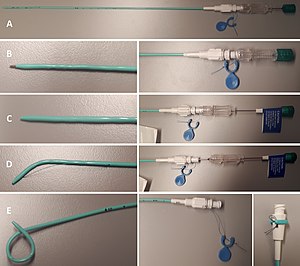Nephrostomy change
Author:
Mikael Häggström [notes 1]
The following procedure refers to the replacement of a transcutaneous pigtail catheter where the tip is intended to be in the renal pelvis.
Contents
Main steps

A. Overview
B. Both puncture needle and obturator engaged. (not used in nephrostomy change)
C. Puncture needle retracted. Obturator engaged. In nephrostomy change, remove any puncture needle before the intervention
D. Both obturator and puncture needle retracted, when the catheter is in the renal pelvis.
E. Locking string is pulled (bottom center) and then wrapped and attach to the superficial end of the catheter.
* denotes the steps that should be done in fluoroscopy.
Preparations
- Consider ensuring that a senior colleague is available for assistance if needed.
- Engage the obturator of the catheter, but loose enough so that you can remove it with one hand if needed.
- Position the patient on the side
Time usually allotted: 30 minutes.[1]
Coagulation: Low risk of bleedingThis procedure counts as conferring a relatively low risk of clinically significant bleeding.[2] Required lab testNone necessary. Lab interpretation
Anticoagulant medication
|
Removal of previous catheter
- Check the position of the previous catheter tip with a few ml of iodinated contrast (enough to delineate the renal pelvis but yet not obscuring the catheter tip), preferably in two projections such as a lateral and a more frontal one.*
Troubleshooting: Catheter in calyx - Loosen the pigtail[notes 2]
- Insert a guidewire (such as Amplatz) into the renal pelvis or proximal ureter.*
Troubleshooting: Cannot advance guidewire - Remove the previous catheter while keeping the guidewire in place[notes 3].*
Troubleshooting: Catheter stuck
Insertion of new catheter
- Insert the new catheter with obturator over the guidewire,[notes 4] keeping the same direction as the guidewire through the tissues to avoid pulling or kinking it.*
- Enter the renal pelvis with the obturator, and then advance with only the soft catheter.*
- Confirm proper location within the renal pelvis by injection of a few ml of contrast, with two projections from different directions.*
- Fixate the pigtail of the catheter.
- Confirm functionality by injection of a few ml of contrast, looking for spontaneous dripping from the catheter when left open, as well as aspiration of the contrast.*
Check whether there is blood or pus in the aspirate or spontaneous return. - Attach the outside end of the catheter to a bag.[notes 5]
- Fixate the catheter to the skin, preferably both directly at insertion as well as enough to the side to have a soft S-shaped bend of the catheter in order to give certain room for stretching without pulling the catheter.
Troubleshooting
- Catheter in calyx
If a previous pigtail catheter is located in a calyx, push it in with a stiff guidewire (such as Amplatz). If this is not directly successful, try:
- Push the catheter from different angles, and/or rotate.*
- Use the stiffer end of the Amplatz wire.
- Loosen the pigtail.[notes 2]
If this is not successful, possibly use a hydrophilic guidewire to reach the renal pelvis, on which to switch catheters.*
- Cannot advance guidewire
This is probably because of kidney stones in the catheter. Possible measures:
- Try a hydrophilic or smaller guidewire in order to get through the catheter.
- Advance around the catheter with a larger tube.
- If the catheter has been used for weeks, it can generally be pulled out, and a new catheter inserted through the same tunnel without any guidewire.
- Catheter stuck
If a previous pigtail catheter can not be pulled out after loosening of the pigtail threads, it may help to cut off the pigtail threads by the external tip, or even cutting off the entire external tip, which may loosen the threads.
Report
- Position of the previous catheter.
- Absence of complications, or a description thereof.
- Type, size and position of the new catheter.
- Color of urine. Signs of blood or pus, if suspected.
| Example: Previous/Old pigtail is located in an inferior calyx. It it pushed into the renal pelvis with an Amplatz guidewire, followed by change to a new 8 French pigtail catheter with locking string. No complications. Spontaneous return of clear urine.
|
- See also: General notes on reporting
Notes
- ↑ For a full list of contributors, see article history. Creators of images are attributed at the image description pages, seen by clicking on the images. See Radlines:Authorship for details.
- ↑ 2.0 2.1 Often by loosening a thread that keeps the pigtail spiraled.
- ↑ Always keep at least one hand on the guidewire. The grip needs to be switched to just above the skin as the catheter tip exits.
- ↑ It is useful to let an assistant advance the catheter tip until reaching skin level, letting you keep the position of the guidewire.
- ↑ Plug it only if there is a clear plan to attach a bag at a specific later time.
References
- ↑ . Change of Nephrostomy. Brighton and Sussex University Hospitals. Publication Date: February 2018.
- ↑ The coagulation section follows local practice at: NU Hospital Group, Sweden